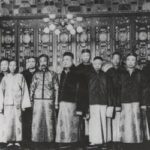One of our oldest human rights, habeas corpus safeguards individual freedom by preventing unlawful or arbitrary imprisonment. This documentary examines habeas corpus and the separation of powers in the aftermath of the 9/11 attacks as the Supreme Court tried to strike a balance between the president’s duty to protect the nation and the constitutional protection of civil liberties in four major Guantanamo Bay cases: Hamdi v. Rumsfeld, Rasul v. Bush, Hamdan v. Rumsfeld and Boumediene v. Bush.
Closed captions available in English and Spanish.
Rights at Risk in Wartime
The terrorist attacks on Sept. 11, 2001, stunned the nation. As commander-in-chief, President George W. Bush responded quickly but soon all three branches of government would be embroiled in the struggle to balance national security with the protection of individual liberties amid a war on terror. This lesson plan is based on the Annenberg Classroom video “Habeas Corpus: The Guantanamo Cases.” The four cases are examples of how the Supreme Court, the president and Congress fought to balance national security and civil liberties during the war on terror. At the heart of each case was the constitutional right of habeas corpus, the right to have one’s detention or imprisonment reviewed in court.
Constitutional Index – Habeas Corpus Clause
The Constitutional Index breaks down the U.S. Constitution by Section, Amendment, and Clause and contains broader topics and themes. These are used to cross-reference Library resources in an effort to annotate constitutional history.
Boumediene v. Bush (2008)
Do detainees at Guantanamo Bay have the constitutional right to challenge the legality of their confinement using a writ of habeas corpus? This case summary shows how the Supreme Court answered that question in 2008.
Calcano-Martinez v. INS (2001)
Does the Illegal Immigration Reform and Immigrant Responsibility Act violate the due process clause by suspending habeas corpus or limiting access to the courts? This case summary shows how the Supreme Court answered that question in 2001.
Hamdan v. Rumsfeld (2006)
Does the Detainee Treatment Act take away the Court’s authority over habeas petitions filed by Guantanamo detainees that were pending at the time of its passage? This case summary shows how the Supreme Court answered that question in 2006.
Abraham Lincoln and Executive Power
This lesson traces the rise of Abraham Lincoln from his humble beginnings to the presidency. It examines Lincoln’s ideas and decisions regarding slavery and the use of presidential power to preserve the Union during the Civil War. After the lesson, students should be able to explain how Lincoln overcame daunting disadvantages to become a great president, analyze and evaluate his decisions in response the critical constitutional issues of the Civil War, and understand and appreciate his legacy to American constitutionalism and citizenship.
Hamdi v. Rumsfeld (2004)
Can a U.S. citizen captured in Afghanistan, who the President claims was an “enemy combatant,” be detained indefinitely? This case summary shows how the Supreme Court answered that question in 2004.
Yick Wo and the Equal Protection Clause

This documentary examines the case Yick Wo v. Hopkins (1886) in which the Supreme Court held that noncitizens have due process rights under the Fourteenth Amendment’s equal protection clause. A PDF lesson plan accompanies the video. The video A Conversation on the Importance of the Yick Wo Case complements the documentary.
